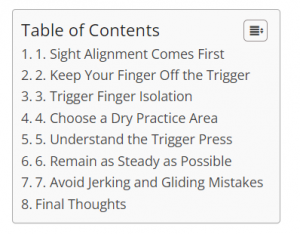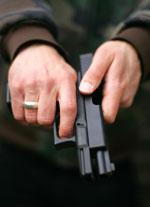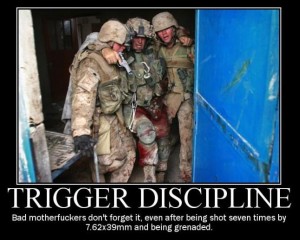LA Times:
One sheriff’s deputy shot himself in the leg while pulling out his gun to confront a suspect.
Another accidentally fired a bullet in a restroom stall. A third deputy stumbled over a stroller in a closet as he was searching for a suspect, squeezing off a round that went through a wall and lodged in a piece of furniture in the next room.
Accidental gunshots by Los Angeles County sheriff’s deputies have more than doubled in two years, endangering bystanders and occasionally injuring deputies. The jump coincides with the department’s move to a new handgun that lacks a safety lever and requires less pressure to pull the trigger.
Sheriff’s officials say that the increase in accidental discharges — from 12 in 2012 to 30 last year — occurred because deputies were adjusting to the new gun. They expect the numbers to fall in the years ahead. So far this year, the department has recorded seven accidental discharges, five of which involved the new weapon.
But the problems may not be over, as more deputies switch to the Smith & Wesson M&P9. In response, department officials have imposed extra training requirements.
The M&P has obvious benefits. It is easier to shoot accurately, can be fired more reliably under stress and is a better fit for people with small hands. The switch was prompted in part by the threat of a lawsuit by women who had failed the Sheriff’s Academy. More recruits — including more women — are now passing the firearms test, and veteran deputies are also logging better scores at the firing range.
But the sharp increase in accidental discharges has prompted an investigation by the Sheriff’s Department’s new inspector general. Critics say this type of semiautomatic, which is widespread in law enforcement and includes the Glock used by many agencies, is too easy to misfire.
Bob Owens, editor of BearingArms.com, says the design of the Glock and the M&P makes such tragedies more likely. “I don’t think, with the amount of training most agencies have, that a gun that has so few tolerances for mistakes is the best choice,” he said.
For two decades, L.A. County sheriff’s deputies carried the Beretta 92F, a heavy metal gun with a large grip.
People with small hands often have trouble flipping up the Beretta’s safety as they prepare to fire. The first shot requires 12 to 15 pounds of pressure on the trigger, forcing some to use two fingers and reducing shooting accuracy for many. Subsequent shots take about 4 pounds of pressure.
The M&P is made of lightweight polymer, with a hand grip that comes in three sizes. Firing a round is as simple as pulling the trigger with a consistent 6 to 8 pounds of pressure.
Sheriff’s deputies have the option of sticking with the Beretta, and some have, saying they are used to it. But many who have switched to the M&P say their shooting has improved.
“At first, I thought, ‘No way, I’m keeping my Beretta forever,'” said Sgt. Mike Rafter, a firearms instructor. “Then I started shooting, and it’s a lot nicer. I can shoot better, and I’m more confident.”
Academy trainees began receiving M&Ps in 2011 and the rest of the department began gradually switching to the new gun soon after. About half of sworn personnel are now using the M&P and more are changing over. As more deputies converted to the M&P, accidental discharges rose.
This is rich. In spite of the silly article that Bob Owens wrote on the Glock and the silly accusations in this article, the truth does come out.
They are blaming it on a SA/DA pistol because of the heavy trigger pull for the first round (although I have to say that 6-8 pounds isn’t exactly a light trigger pull for the M&P). Thus they have trained officers to keep their fingers on the trigger of their handguns when they deploy their firearms. They say so.
Think about that and let it wash over you again. When a cop pulls his handgun and points it your direction, according to the training he has received, he most likely has his finger on the trigger of the weapon. And thus do we reach the root cause of the problems – not Glocks, or M&Ps, or any other ridiculous culprits. It’s a shame that Bob couldn’t have pointed out the truth rather than blame the gun. Blaming the gun is what gun controllers do, and why the collectivists wanted the so-called smart gun.
So other than reminding you that this violates two of the sacred rules of gun safety (muzzle discipline and trigger discipline), let’s rehearse sympathetic muscle reflexes again, and I’ll remind you of what I said about how the Marine Corps trained my son Daniel as a SAW gunner. First concerning sympathetic muscle reflexes.
The term sympathetic contraction refers to the fact that an involuntary contraction may occur in the muscles of one limb when the same muscles in the other limb are performing an intended forceful action. In physiology literature this effect is known as a mirror movement, with the intensity of the sympathetic contraction depending on the amount of force exerted during the intended action. In policing, a common situation that may evoke such a sympathetic contraction would be, for example, a law enforcement officer attempting to restrain a struggling suspect with one hand while holding a handgun in the other.
The second scenario described by Enoka involves loss of balance. When balance is disturbed the human body evokes rapid involuntary contractions to return itself to a position of equilibrium. Thereby the involuntary contractions used to prevent a fall depend on the options available to counteract the disturbance of balance. Usually, compensatory movements following gait perturbations primarily involve correcting movements of the lower limbs to keep the body in balance, whereas movements of the arms are restricted to their extension forwards as a safeguard to counter an eventual fall. When an individual is holding a handle for support, there is, however, a tendency to use the arm muscles to maintain balance rather than the leg muscles. Under such circumstances the focal point of automatic postural activity is any contact point an individual has with his or her surroundings. In other words, if an individual’s posture is disturbed while grasping an object, for instance a handgun, he or she is likely to grasp it more forcefully.
Startle reaction, the third scenario identified by Enoka, is a whole-body reflex-like response to an unexpected stimulus, possibly a loud noise. It evokes rapid involuntary contractions that begin with the blink of an eye and spread to all muscles throughout the body. The reaction of the hands occurs less than 200ms after the stimulus and leads to individuals clenching their fists. Enoka concludes: “Accordingly, an officer who is startled by a loud, unexpected noise while searching for a suspect with his weapon drawn would surely increase the grip force on the weapon, perhaps enough to cause an involuntary discharge.”
Next concerning training.
My son was a SAW gunner in the 2/6 infantry, Golf Company, 3rd Platoon, during the 2007 combat tour of Fallujah and the pre-deployment workup. The senior Marines had experienced a tour of Iraq, and wanted their SAW gunners to have a round in the chamber, bolt open (the SAW is an open bolt weapon anyway), and finger on the trigger. They had seen combat and they wanted their SAW gunners with zero steps to shooting. Their lives depended on it. They also did CQB drills with live rounds, along with squad rushes.
My son had an ID (if I’m not mistaken it was during training at Mohave Viper). He tripped and had a sympathetic muscle reflex, squeezing the trigger of his SAW. He spent an extended period of time in the “room of pain.” They wanted him trained to overcome that sympathetic muscle reflex (which can be done, but it takes hundreds or thousands of hours of drills). He spent the time learning to overcome that reflex, and performed well during his tour. He also tried to teach his “boot” Marines the same way he was trained, but the Marines had begun to change and focus more on cultural sensitivity training and other COIN tools. He got out of the Marine Corps.
Why am I discussing this? Because no matter who you are, no matter how much time you spend, no matter how earnestly you wish it, no matter how many directives you write, if you are a SWAT team member, you will never be trained in such a manner. Never. You will never be trained like a U.S. Marine who has spent every day for a year and a half in pre-deployment workup to do a combat tour of Iraq. Because you will never be trained in this manner, your tactics are dangerous, all of the time, and in all situations. I don’t care how many times you have inexperienced Soldiers spend a week with you doing CQB drills. With the standdown in Iraq and Afghanistan, they oftentimes know as little as you. These tactics place people in danger when there are better alternatives.
In spite of all of this, officer safety is paramount, not your safety. So things we would never do on a range, and never allow our mates to do, are done every day by cops around the country. They keep their fingers on the triggers of their weapons when they deploy them. They are trained to do it. And Bob Owens, along with the LAPD, blame guns with light trigger pulls rather than the horrible safety protocols police use. They would apparently rather continue the tradition of ignoring trigger discipline and use pistols with a heavy trigger pull to ameliorate sympathetic muscle reflexes rather than teach cops to follow the rules of gun safety.
Good grief. Horrible. Just horrible.
Prior: Gun-Mounted Flashlights Linked To Accidental Shootings






